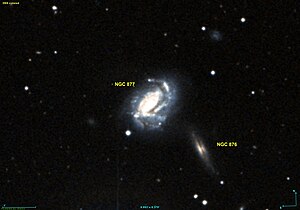NGC 876
| Galaxy NGC 876 |
|
|---|---|

|
|
| AladinLite | |
| Constellation | Aries |
|
Position equinox : J2000.0 , epoch : J2000.0 |
|
| Right ascension | 02 h 17 m 53.3 s |
| declination | + 14 ° 31 ′ 17 ″ |
| Appearance | |
| Morphological type | Sc |
| Brightness (visual) | 13.8 mag |
| Brightness (B-band) | 14.5 mag |
| Angular expansion | 2 ′, 0 × 0 ′, 4 |
| Position angle | 20 ° |
| Surface brightness | 13.4 mag / arcmin² |
| Physical data | |
| Affiliation | LGG 53 |
| Redshift | 0.012876 +/- 0.000057 |
| Radial velocity | 3860 +/- 17 km / s |
|
Stroke distance v rad / H 0 |
(175 ± 12) · 10 6 ly (53.8 ± 3.8) Mpc |
| history | |
| discovery | RJ Mitchell |
| Discovery date | November 22, 1854 |
| Catalog names | |
| NGC 876 • UGC 1766 • PGC 8770 • MCG + 02-06-057 • 2MASX J02175332 + 1431179 • GC 517 • LDCE 158 NED002 | |
NGC 876 is a spiral galaxy of Hubble type Sc in the constellation Aries south of the ecliptic . It is an estimated 175 million light years away from the Milky Way and has a diameter of around 100,000 ly. Together with NGC 877 , it forms a gravitationally bound galaxy pair.
The galaxies NGC 870 and NGC 871 are located in the same area of the sky .
The object was discovered on November 22, 1854 by RJ Mitchell , an assistant to William Parsons , using the Leviathan reflector .
Web links
Commons : NGC 876 - collection of images, videos, and audio files
